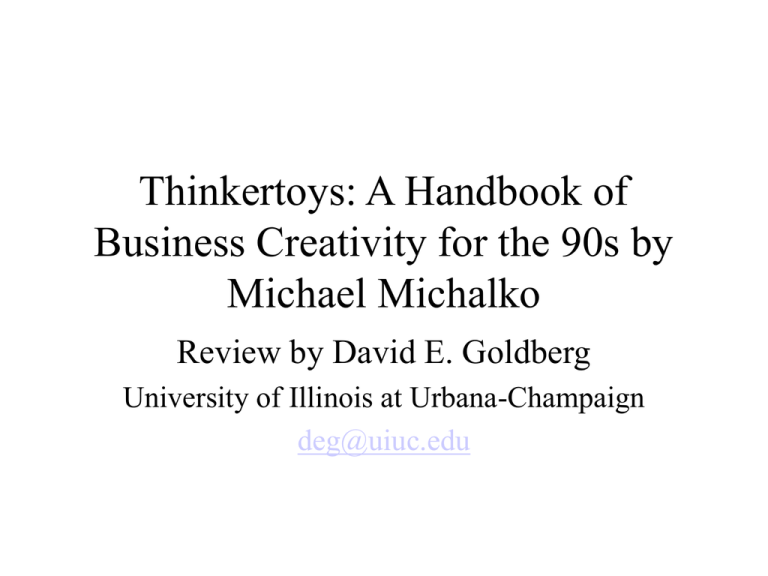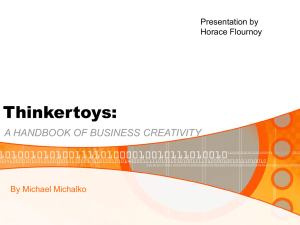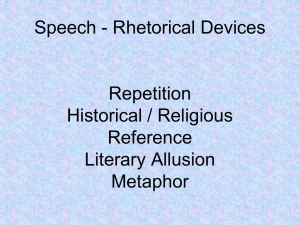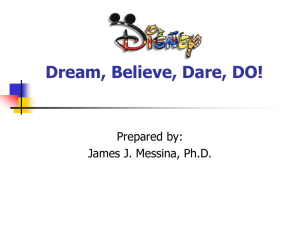deg3
advertisement

Thinkertoys: A Handbook of Business Creativity for the 90s by Michael Michalko Review by David E. Goldberg University of Illinois at Urbana-Champaign deg@uiuc.edu Author & Organization • Author: Full time creativity consultant for F500 firms. • Categories: – – – – Linear thinkertoys Intuitive thinkertoys Group thinkertoys Endtoys Tick-Tock • • • • • Based on work of Prescott Lecky. Need for consistency. Tick: negative views. Tock: refutation of negative view Related: – Creative is as creative believes. – Remember successes. – Write what you wish to be true. Mind Pumping • • • • • • • • • Idea quota Getting tone: really paying attention. Dukes of habit: intentionally changing habits. Feed your head: select carefully, outline, take notes. Content analysis: attention to world around you. Brainbanks: clippings in a bucket. Travel junkie Capturing idea birds. Idea log: categories of interest. Challenges • • • • Journal of problems Bug list List of benefits Challenge statement – – – – In what ways might I … Synonyms Stretch Decompose, why else, how else? Linear Thinkertoys • Reverse assumptions • Slice and dice • Cherry picking: describe challenge in two words, split attributes. • Think bubbles: mind map of related ideas. Scamper • Based on Osborn – – – – – – – Substitute Combine Adapt Modify Put to other uses Eliminate or minify Rearrange Tug of War • • • • Write challenge Describe best case and worst case List conditions of the situation Note tug of war Idea Box • • • • List challenge List parameters List variations Try different combinations Idea Grid • FCB Grid by Richard Vaughn, of advertising firm Foote, Cone, & Belding. • High-low involvement vs. think & feel. • Marketing of products. Toothache Tree • Fishbone diagram. • State challenge • Identify major obstacles Phoenix List • List of questions at CIA • Steps: – Write your challenge – Ask Phoenix questions – Record answers What is Your Business? • Steps: – Ask what is our business? – Define products/services, markets, functions, technologies. – Under each, write keywords – Mix and match to explore new ideas. Future Fruit • Steps: – – – – – – Identify a problem. State a decision to be made Identify the forces that impact on decision Build scenarios based on principal forces Develop scenarios into narratives Search for business opportunities in each Brutethink • Random stimulation + forced connection • Steps: – – – – Bring in a random word (truly random) Simple and familiar words the best. Think of variety of things related to the word Make forced connection to challenge Hall of Fame • Inspiration from and forced connection to famous words: • Steps: – – – – – Make list of people you admire Choose an advisor and pick a quotation Ponder the quotation Choose thought or combo of thought that holds promise Allow 5-10 minutes to generate ideas Circle of Opportunity • Perception changes over time. • Steps: – – – – – – – State challenge Draw circle numbered 1 to 12 like clock Select 12 attributes specific to challenge Throw one die to pick first attribute Throw two dice to pick second attribute Consider them singly and together Write down associations as they occur Ideatoons • Left-right shift and bridge • Steps: – Divide challenges into attributes – Describe each attribute by drawing abstract symbol on separate card (label on back) – Look for ideas to link to your challenge – Add ideatoons as necessary Clevor Trevor • Bust blocks of expertise • Steps: – – – – Talk to someone outside your field Seek idea people Draw out creativity in strangers you meet Listen Chilling Out • Alpha waves promoted by – – – – Quiet environment Specific technique Passive attitude Comfortable position • Techniques: body relaxation, meditation, Truman’s foxhole Blue Roses • Managers use intuition (Isenberg): – – – – – Sense problems Perform well-learned patterns Synthesis of pattern Gutcheck rational answer Bypass rational answer with quick solution • Intuition must be developed and incorporated with reason. Three Bs • Great discoveries made in bus, bed, or bath. • Need to encourage incubation. • Steps: – – – – – Identify challenge. Prepare: collect data Instruct brain to solve Incubate: let go Eureka Rattlesnakes and Roses • Analogical reasoning: personal, direct, symbolic, fantasy. • Steps: – – – – – State challenge Choose keyword in challenge Choose parallel or distant field List images of parallel field, choose rich ones. Look for similarities and connections between two components of the analogy Stone Soup • Radical “What if” leads to radical solutions • Steps: – Stipulate challenge – List as many “what if” challenges as possible. – Answer questions posed by challenges Color Bath • Steps: – – – – Relaxation Select basic color Imagine color as small ball of light Affirm the color • Variations – Talking to an object (money) Dreamscape • Use dreams actively to solve problems. • Steps: – – – – Formulate question about challenge Wake up early to record dream Record dream in dream journal How were people, places, and events related to query? What is answer from dream? Da Vinci’s Technique • Use drawing and thinking to solve problems. • Steps: – – – – – – – Review challenge Relax Choose format Draw without conscious direction Examine drawing Write down first word that comes to mind Combine words to form paragraph & relate to challenge Dali’s Technique • Hypnogogic imagery • Steps: – – – – – – Think about challenge Relax Quiet mind Quiet eyes Record experiences immediately Look for associations Not Kansas • Steps – – – – Relax Ask unconscious for answer Take guided imagery tour Accept whatever messages occur Rice Storm • Steps (for problem understand or solution): – Leader expresses area of concern – Each person writes facts (one per card) on cards related to concern – Redistribute cards – Leader picks and reads one card. – Others select related facts – Give grouping a name – Continue until all words in name sets.








